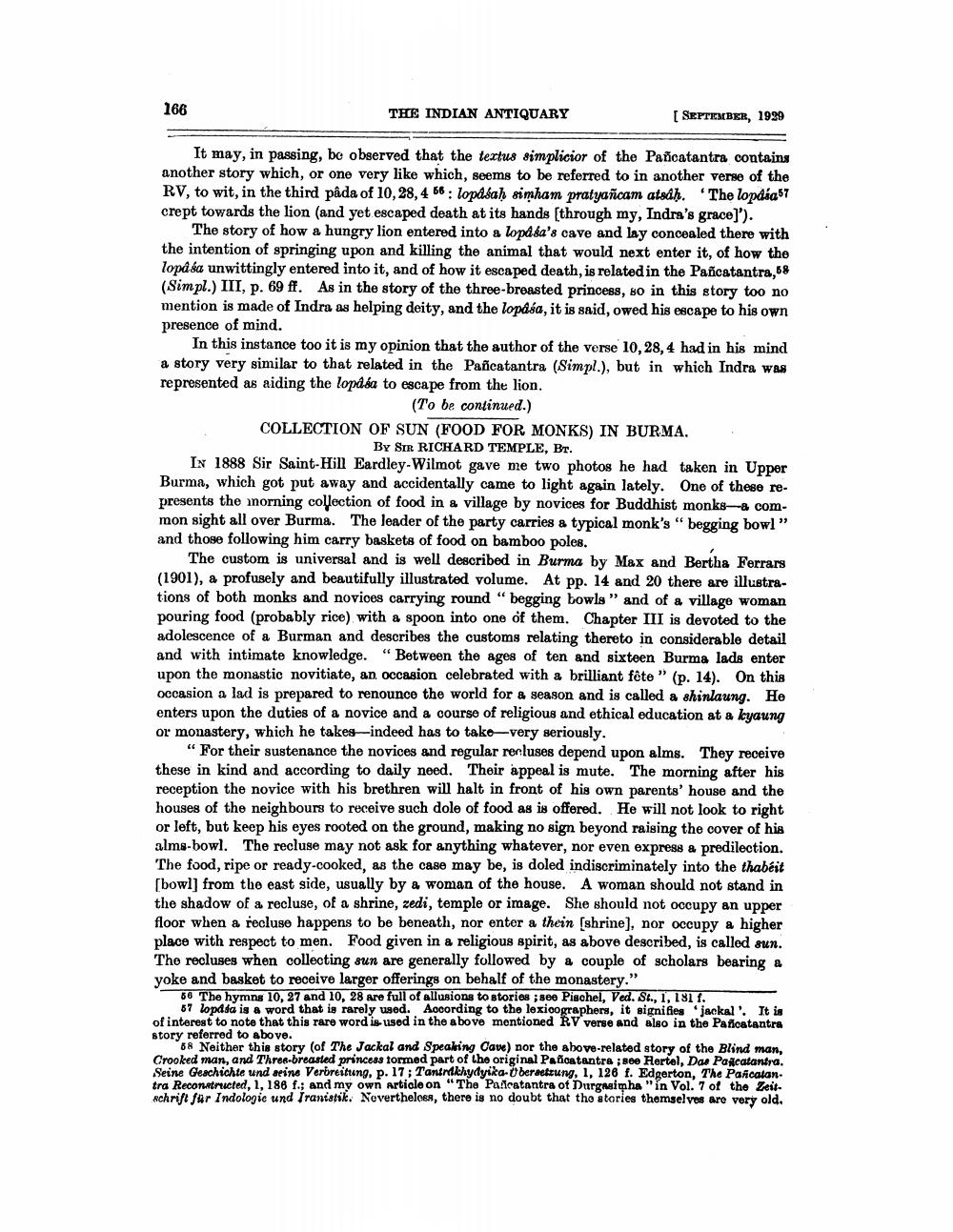________________
166
THE INDIAN ANTIQUARY
[ SEPTEMBER, 1929
It may, in passing, be observed that the textus simplicior of the Pañcatantra contains another story which, or one very like which, seems to be referred to in another verse of the RV, to wit, in the third pâda of 10, 28, 4 56: lopásaḥ simham pratyañcam atsaḥ. The lopdia57 crept towards the lion (and yet escaped death at its hands (through my, Indra's grace]').
The story of how a hungry lion entered into a lopása's cave and lay concealed there with the intention of springing upon and killing the animal that would next enter it, of how the lopása unwittingly entered into it, and of how it escaped death, is related in the Pañcatantra,58 (Simpl.) III, p. 69 ff. As in the story of the three-breasted princess, so in this story too no mention is made of Indra as helping deity, and the lopása, it is said, owed his escape to his own presence of mind.
In this instance too it is my opinion that the author of the verse 10, 28, 4 had in his mind a story very similar to that related in the Pañcatantra (Simpl.), but in which Indra was represented as aiding the lopása to escape from the lion.
(To be continued.)
COLLECTION OF SUN (FOOD FOR MONKS) IN BURMA. BY SIR RICHARD TEMPLE, Br. IN 1888 Sir Saint-Hill Eardley-Wilmot gave me two photos he had taken in Upper Burma, which got put away and accidentally came to light again lately. One of these represents the morning collection of food in a village by novices for Buddhist monks-a common sight all over Burma. The leader of the party carries a typical monk's "begging bowl" and those following him carry baskets of food on bamboo poles.
The custom is universal and is well described in Burma by Max and Bertha Ferrars (1901), a profusely and beautifully illustrated volume. At pp. 14 and 20 there are illustrations of both monks and novices carrying round "begging bowls" and of a village woman pouring food (probably rice) with a spoon into one of them. Chapter III is devoted to the adolescence of a Burman and describes the customs relating thereto in considerable detail and with intimate knowledge. "Between the ages of ten and sixteen Burma lads enter upon the monastic novitiate, an occasion celebrated with a brilliant fête" (p. 14). On this occasion a lad is prepared to renounce the world for a season and is called a shinlaung. He enters upon the duties of a novice and a course of religious and ethical education at a kyaung or monastery, which he takes-indeed has to take very seriously.
"For their sustenance the novices and regular recluses depend upon alms. They receive these in kind and according to daily need. Their appeal is mute. The morning after his reception the novice with his brethren will halt in front of his own parents' house and the houses of the neighbours to receive such dole of food as is offered. He will not look to right or left, but keep his eyes rooted on the ground, making no sign beyond raising the cover of his alms-bowl. The recluse may not ask for anything whatever, nor even express a predilection. The food, ripe or ready-cooked, as the case may be, is doled indiscriminately into the thabéit [bowl] from the east side, usually by a woman of the house. A woman should not stand in the shadow of a recluse, of a shrine, zedi, temple or image. She should not occupy an upper floor when a recluse happens to be beneath, nor enter a thein [shrine], nor occupy a higher place with respect to men. Food given in a religious spirit, as above described, is called sun. The recluses when collecting sun are generally followed by a couple of scholars bearing a yoke and basket to receive larger offerings on behalf of the monastery."
56 The hymns 10, 27 and 10, 28 are full of allusions to stories ; see Pischel, Ved. St., 1, 181 f.
57 lopása is a word that is rarely used. According to the lexicographers, it signifies jackal'. It is of interest to note that this rare word is used in the above mentioned RV verse and also in the Pañcatantra story referred to above.
58 Neither this story (of The Jackal and Speaking Cave) nor the above-related story of the Blind man, Crooked man, and Three-breasted princess tormed part of the original Pañcatantra ; see Hertel, Das Pascatantra. Seine Geschichte und seine Verbreitung, p. 17; Tantrakhydyika-Übersetzung, 1, 126 f. Edgerton, The Pañcatan. tra Reconstructed, 1, 186 f.; and my own article on "The Pañcatantra of Durgasimha "in Vol. 7 of the Zeitschrift für Indologie und Iranistik. Nevertheless, there is no doubt that the stories themselves are very old.




